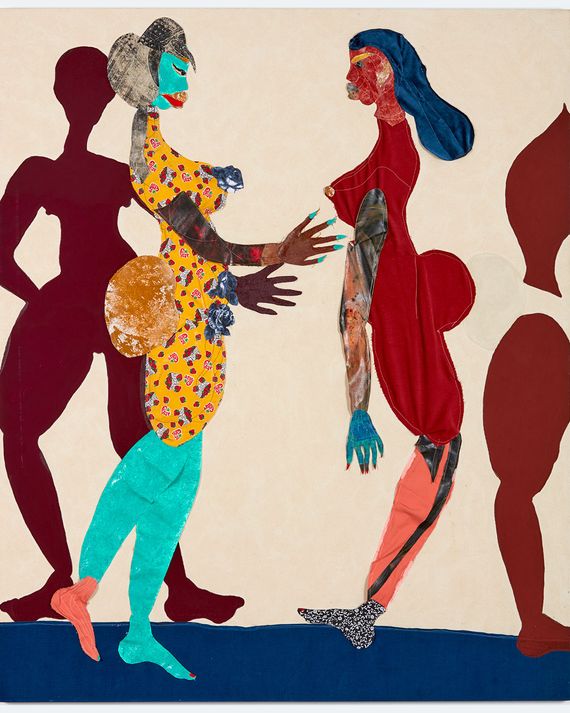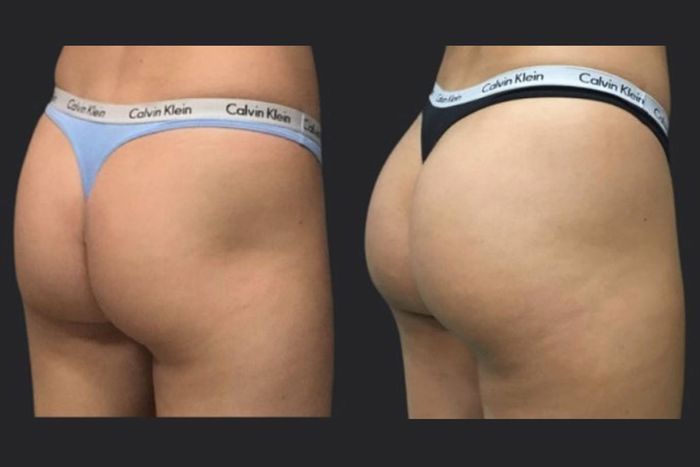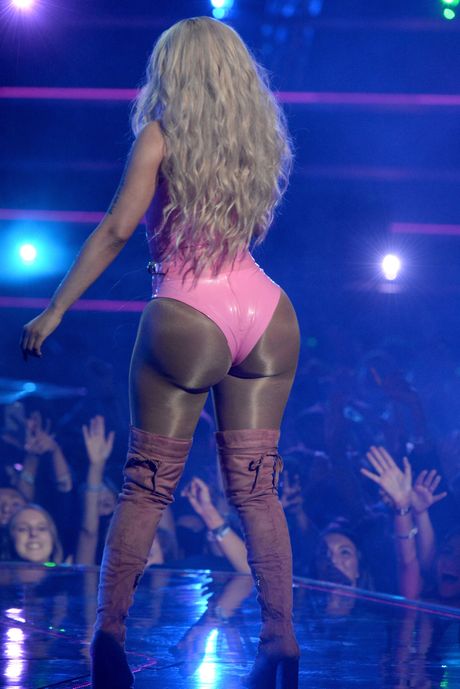
For years now, the Black plastic surgeon Dr. Charles Boyd has noticed a common request among his white millennial patients. They want bigger lips, yes, but specifically a top lip that is the same size as the bottom, instead of the industry-standard recommendation of lip proportions of one-third to two-thirds, top to bottom. Through his work as a plastic surgeon and educator, Boyd knows that this 50-50 ratio is usually found on Black women. He started highlighting that fact for his colleagues, other physicians and practitioners whom he trains to create those lips via injections. “That one-third–two-thirds thing came from [the aesthetics industry] only studying white women who had thin lips, and that’s the proportion they had. But that’s not what’s desired anymore,” says Boyd, whose practice is based in Birmingham, Michigan. “They know that fact as well as I do, but it’s important to say it — to say these are Black women’s lips so they know what they’re asking for.”
He has seen the body ideal shift, too, from big breasts and straighter hips to what he describes as “all of the curves that Black women have been blessed with forever and many times ostracized for.” The look is an hourglass shape pushed to its extremes — tiny waist, wide hips, and the key: a large, high butt. It’s achieved primarily through a “buttock augmentation through fat grafting,” removing fat usually from the abdomen via liposuction, then transferring it to the hips and butt, a procedure popularly known as the “Brazilian butt lift” or BBL.
Now we see it on countless everyday influencers. But early on, celebrities were its adopters — Nicki Minaj and the majority of the Kardashian-Jenner family have the shape, though none has copped to having the procedure. Although the BBL’s popularity has been growing over the past decade, we have now reached a unique point of both mainstreaming and frenzy. Before-and-after-BBL TikTok is a thing, of course, and so is BBL Pinterest: mostly as-cheery-as-possible lists of recovery tips and DIY recovery chairs (no sitting allowed for at least two weeks post-op). Back in June, a widely circulated video depicted a couple dozen women in wheelchairs departing the Santo Domingo airport on a flight to Atlanta after presumably having BBL surgery. (The Dominican Republic is a popular plastic-surgery-tourism destination.) And then there was the viral image of an email allegedly sent from a Miami-area hotel informing its patrons that it had neither the equipment nor the infrastructure to support post-op-recovery stays. (Miami too is a popular destination for BBL surgery.)
Boyd now sees about five BBL consultations a week. A few years ago, he might have gotten that number in a month. According to the American Society of Plastic Surgeons, from 2017 to 2019, BBL procedures grew by 38 percent (the number dropped by 22 percent in 2020, but that decline is likely owed to COVID).
The racial makeup of the BBL seeker is varied: Middle Eastern, Black, Hispanic, white. “I don’t think people would give Black women credit for [this aesthetic], but they definitely want [the look],” says Boyd. “Maybe it’s closer to getting a tan. White people have always gotten a tan, but they never said they’re tanning to look less white — and certainly not more Black.”
I began to understand that butts were becoming a thing for white folks probably as early as 2013. At first, the idea was a puzzling joke. I thought, Okay, y’all are real late, as usual. I grew up in Detroit in the ’90s, which by then had been an all-Black city for 20 years. I had become resigned to white society embracing “trends” yet not the Black cultural origins of those trends. Today’s chic gold-ring-and-necklace stacking was simply how everyone around me wore jewelry in middle and high school. The New Balance 990s and Air Force 1’s Black teens rocked with the first-day-of-school fit eventually became “dad sneakers” popularized by thin white models.
Slowly, though, I allowed that the butt trend felt unique. Fashion-magazine articles placing white women, like Instagram fitness influencer Jen Selter and Kim Kardashian, on the big-booty vanguard were painful. It was as if our very bodies were being appropriated. And unlike our sneaker game or how we style our jewelry, we can’t take this off and come up with some new dope shit. We can’t move on from our Black female bodies or the exploitative history associated with them.
At the same time big butts became ascendant, Miley Cyrus began her unfortunate twerking tear. At the 2013 VMAs, she effectively used brown-skinned Black women with curvy, thick bodies as animated props in her “We Can’t Stop” performance. Sociologist, professor, and author of Thick Tressie McMillan Cottom described the ass-slapping circus scene in Slate:
Playing the desirability of black female bodies as a wink-wink joke is a way of lifting up our deviant sexuality without lifting up black women as equally desirable to white women … She is playing a type of black female body as a joke to challenge her audience’s perceptions of herself, while leaving their perceptions of black women’s bodies firmly intact. It’s a dance between performing sexual freedom and maintaining a hierarchy of female bodies from which white women benefit materially.
Cyrus had attempted to level up her own popularity, marketability, and music-industry credibility by juxtaposing herself with thick Black bodies. It’s an exploitation of Black women as old as the history Black people in America.
Slowly over the past decade, the trend that began with twerks morphed. As the body-positivity movement (which, notably, left behind fat Black women with less socially desirable shapes) elevated the likes of “curvy” women Ashley Graham and Iskra Lawrence, butts themselves became the focus. The look-over-the-shoulder pose began to dominate Instagram feeds. The cultural and social value of BBL flowed from Black women to white women, and it has been entirely commodified. Anybody can have a big butt for a price (the procedure starts at about $5,000).
There is, of course, some benefit to the expansion of what we think is beautiful. After 50-plus years of covers featuring all-American girls in bikinis, Sports Illustrated’s annual swimsuit issue couldn’t be any more representative of what is now mainstream. This year’s three cover models were all Black women: Naomi Osaka, Megan Thee Stallion, and Leyna Bloom. Bloom is the franchise’s first transgender cover star, Osaka its first Black female athlete, and Megan its first rapper. And Megan’s curves too were new. A thick-girl shape, not necessarily enhanced by cosmetic surgery, but a thickness that’s forever loved by the Black community. The covers felt fresh and current.
And yet Black women who pursue the beauty ideal through cosmetic surgery are still often punished for it. Wendy Osefo, professor of policy and urban education, political commentator, and Real Housewife, got a breast augmentation and a BBL earlier this year. After having her third child in 2019, she felt like “a shell of herself,” she says. She wanted breast augmentation and lipo at first, but then realized she could put the extracted fat elsewhere. She chose her butt. “I was never voluptuous back there. I probably have what some would consider a skinny BBL because I didn’t even have that much fat,” says Osefo. She revealed her post-surgery results on the season-six Real Housewives of Potomac premiere. While she has gotten applause for her transparency and agency, there have been criticisms. Some women feel as though her professionalism as an educator has been compromised by the pursuit of bigger breasts and butt. “Every time I take ownership of my femininity or my sexuality on my terms, women attack me,” says Osefo. “It’s almost as if women are attacking me because misogyny has been ingrained in how we were raised.”
In late May, Hazel-E posted a video of herself dancing in her pool in a snakeskin-print bikini. She adjusts her top and bottom, then turns her butt to the camera and jiggles it a bit for her 1 million Instagram followers. For the rapper and Love & Hip Hop star, this was a moment of relief and progress. Ten weeks prior, she had gone to Turkey for a mommy makeover and experienced disastrous, life-threatening complications. Now she was finally starting to feel better, healthy — like herself. So she posted. The backlash — in the comments and on gossip sites — was swift. “I got dragged to hell and back,” she says.
“You almost died for this??? For that odd bellybutton and almost left your daughter motherless?!”
“Girl, get you some mental health because no matter what procedure you acquire, your body doesn’t look good.”
“Let’s be real right now. Your ass looks like a diaper full of shit.”
“You’re built bad. The doctor should’ve added some hips.”
Hazel-E had, in fact, already gotten her butt done. First, in 2014, she had “butt shots,” hyaluronic-acid filler injected into her butt to make it bigger. Back then, she had just finished her first season of Love & Hip Hop, throughout which, she says, she was constantly criticized for her figure — called a “linebacker” and “SpongeBob” — by internet trolls. So in January 2015, before her second season, she got a BBL. “The bigger butt was definitely on the list,” says Hazel-E. “If I had a bigger butt, then maybe I’d get this attention. I wanted to emulate that Love & Hip Hop–girl standard.”
The backlash to her joyful “bikini body” video made Hazel-E feel she had to explain herself. Why wouldn’t she be proud of her own body, despite the “imperfection” that was shouted back to her through the internet? “There’s always an argument around that when Black people, especially, pursue plastic surgery — Do you not love yourself?” says Boyd. “It does us a disservice to go down that road, because it leaves it so that other people can enhance themselves but we can’t.” As Chenjerai Kumanyika, an assistant professor of journalism and media studies at Rutgers, puts it, “Capitalism extracts from Black culture, but then American society still uses that culture to discipline and police Black people.”
In reality, the BBL body isn’t a prototypical Black woman’s body. It is a Frankenstein’s monster created mostly by pop culture, social media, and the beauty industry. At least, as far as we know. There’s hardly any research on differences among races that might inform the discourse. “One of the only things that’s really discussed and published among surgeons is rhinoplasty,” says the New York–based plastic surgeon Dr. Andrew Jacono, who’s now studying differences in face-lift scarring in skin of color. “You go to a rhinoplasty conference and there’ll always be lectures that are specific to Asian, African American, and Latino rhinoplasty. And there are different maneuvers and things that we do in all those different categories.”
It doesn’t help that Black doctors are underrepresented in plastic surgery. A 2017 study showed that only 3.5 percent of the field’s residents were Black. Boyd, who has had his own practice since 2009, says it has long been that way and isn’t getting much better. And though he’s a prominent figure in the field, he talks about white colleagues sometimes mistaking him for other Black surgeons. “I think that [Black people] have always been forced to pay attention to other ethnicities, and they have not had to do the same,” explains Boyd. “They have not been forced to pay attention to us. So they don’t.”
So the BBL body is not of Blackness — at least not entirely. It’s far more exaggerated than what Mother Nature usually delivers. A commonly leveled critique, “The thighs and the ass don’t match,” hints at the distortion of its proportions — a very big butt atop spindly legs, the BBL body belongs to no one.
More From fall fashion issue 2021
- The People Who Make Those $10,000 Couture Gowns
- Am I Ready to Become a Hat Girl?
- The Most Important Fashion Accessory Costs Less Than $4






